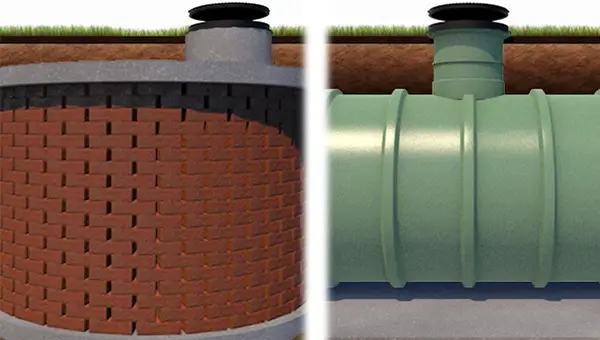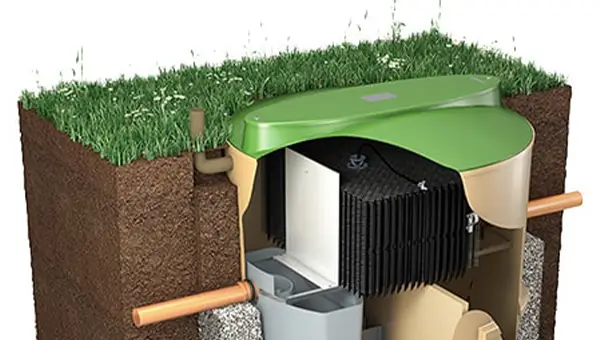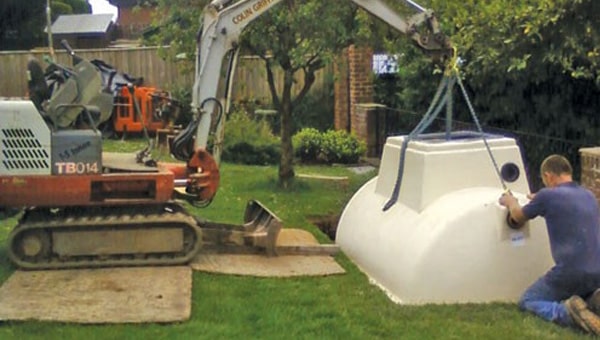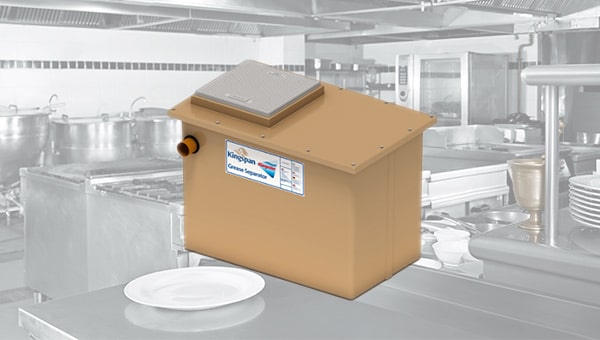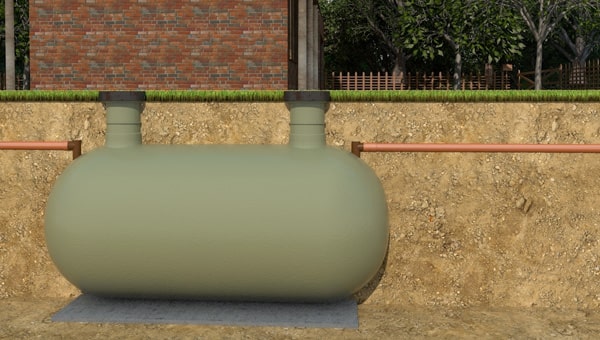
Off-mains drainage is a serious business. We all want our wastewater to simply disappear when we flush a chain or pull a plug, without needing to give it another thought. For most of us, this is exactly how it works. However, it is becoming more and more common for properties to require an off-mains drainage system, either because they are too far from a mains connection, or because the mains system in the area has reached capacity. One such solution to this problem is the installation of a sewage treatment plant.
If you are buying a newly built house that requires an off-mains system, this will most likely have been taken care of by the builders already, and you need only concern yourself with the running of the system. Check out our “How to operate and maintain a sewage treatment plant” article for advice on this.
But what if you are moving into an existing property with, or are the owner off, an older off-mains system that needs replacing? What if you need to have a new sewage treatment plant installed on your property? How do you plan for it, and what important things do you need to consider? These are the questions that this guide will attempt to answer. Let’s begin by taking a look at the regulations surrounding sewage treatment plants.
Note: This article assumes that you are fully aware of all the off-mains solutions available to you and that you have chosen a septic tank to be the most suitable. If you are unsure about any of this, we recommend first taking a look at our guide to off-mains drainage article.
Understanding Sewage Treatment Plant Legislation
The installation of an off-mains drainage system can be a daunting prospect when you start looking into all the legal aspects. There are rules and regulations for everything from the type of tank that is appropriate for a property to where it can be installed, where it can discharge to, and what kind of ground conditions are acceptable.
Complying with all of these regulations is of paramount importance, as failure to do so can be disastrous for the environment and leave you, the property owner, open to prosecution. Your Local Authority and/or relevant environment agency have the power to test any off-mains/private drainage system that they feel isn’t complying with the regulations and can ultimately take legal action if that is/continues to be the case.
It is, therefore, imperative that you ensure full understanding of and adherence to all the regulations that will affect your installation and running of a sewage treatment plant. This is the sole responsibility of the property owner and should be taken very seriously.
For this reason, reviewing the General Binding Rules should always be the starting point for any non-mains foul drainage system in England. This should govern the planning of your system and will inform whether a permit from the Environment Agency would be required.
This article focuses on the rules and regulations for installing sewage treatment plants in England. Different rules exist for installations in Northern Ireland, Scotland and Wales. Consultant the respective national environment authorities for further details.
The following points offer a quick overview of the main rules for sewage treatment plants:
- All sewage treatment plants must be EN12566-3 tested and approved for sale and installation to be deemed legal in the UK
- The discharge (or outlet) from the tank must be at least 10 metres away from any water courses or buildings
- If the plant needs electricity to operate it must be able to function without power for up to 6 hours or have an uninterruptible power supply fitted to it
Ideally, if the conditions of the General Binding Rules are met, your sewage treatment plant should be able to discharge into a local watercourse (if conditions aren’t met, you can still apply to the national environment agency for consent to discharge). However, if the conditions aren’t met (and/or consent to discharge has been denied), then your sewage treatment plant will need to discharge into a drainage field/soakaway instead. A drainage field (or soakaway system) is made up of a series of perforated/slotted pipes that provide an additional stage of treatment for the discharged waste. The following additional rules will apply if you do need to install one:
- No part of the drainage field should be within 2 metres of a neighbouring boundary
- It should be at least 15 metres from any building
- It should be at least 50 metres from a water supply (e.g. well or borehole)
- No access roads, driveways or paved areas should be located within the area
If you find that a drainage field is your only discharge option, you may also be able to look at installing a septic tank as a more cost effective alternative to a sewage treatment plant. Check out our septic tank installation guide to compare the steps involved.
We stress that these are just some of the main points we have picked out here. A full reading of the General Binding Rules should be conducted before going any further. If you don’t understand the rules, you shouldn’t be installing a sewage treatment plant yourself. If you are intending to discharge into a watercourse we would highly recommend speaking with a member of our technical team regardless, as they can offer expert advice on the complex rules that surround the ability to do so.
If, however, you have absorbed all the relevant information from the General Binding Rules, like good soil absorbs treated effluent, and are confident you understand how to best ensure your system will comply with all the regulations, the next stage of the process is to perform a site survey.
Conducting a Site Survey
Before you can even think about buying and installing your sewage treatment plant you need to first evaluate the area of install to know what type of system you will need.
Important note: If any part of the building your treatment plant will serve is within 30 metres of a public sewer, you will need to apply to the national environment agency for permission to discharge to an alternate system, and have a good reason for wanting to do so. Typically, they will not permit the use of a private system if a public one is available, as per the General Binding Rules. To find out if there is a public sewer near your property contact your local water authority.
Unfortunately, when it comes to sewage treatment, it’s not always a case of just picking a product “off the shelf” and having it installed. There are many factors that will affect the suitability of any tank to your property, including the type of wastewater to be treated, the effluent output quality needed, the proximity of the intended install point to any buildings, the location of the discharge point, the porosity of the ground if a drainage field is needed and the availability of site access for maintenance.
But how do you find all this out? Well, the first thing to do is check your proposed system would comply with the General Binding Rules, as mentioned above. If, for any reason, it doesn’t, you’ll need to apply for consent to discharge. You'll also need to consent if your planned discharge point would be within 500 metres of any:
- Special areas of conservation
- Special protection areas
- Ramsar sites
- Biological sites of special scientific interest
- Freshwater pearl mussel population
- Protected shellfish water
- Designated bathing water
You would also need a permit if the new discharge would be in or within:
- 200 metres of an aquatic local nature reserve
- 50 metres of a chalk river or aquatic local wildlife site
Unless you are 100% certain that your system would meet these criteria it is highly recommended you contact either JDP’s technical team or your national environment agency directly to check if you’re in or near a designated sensitive area and to find out if you need a permit.
It is also important to check whether you would need building regulations approval and/or planning permission for your sewage treatment plant before you go any further. Failure to comply with or acquire any one of these may prevent your installation altogether.
Assuming that you have done all of these legal checks, and that your property is indeed suitable for a private sewage system, you can then move on to... conducting even more checks - nobody said installing an off-mains system was easy!
Before you can start planning your system, you’ll need to do all of the following:
- Conduct a Groundwater Source Protection Zone Search
- Conduct Trial Site Assessment Hole Test (if you need to install a drainage field)
- Conduct Percolation Tests (if you need to install a drainage field)
- Check that a tank, and a drainage field (if using one), can be situated far enough from habitable dwellings, as per the General Binding Rules
View our dedicated article for how to perform a percolation test for a more detailed description of how to perform these tests and checks, or have a watch of our companion video to see how it's done.
With all these tests and searches complete, and you've checked that the proposed location of your tank will comply with the General Binding Rules, all you will need to do is grab a tape measure and make sure you can fit a sewage treatment plant on your property without it breaking the distancing rules. The following is a summary of recommended guidelines, but please make sure that you check the regulations thoroughly yourself:
- At least 3 metres away from any boundary line of the property
- At least 3 meters away from any significant root systems (i.e. from trees and bushes)
- At least 10 meters away from any habitable building
- No greater than 30 meters away from a hardstanding area suitable for desludging tanker access
Assuming green lights across the board for all of the above, you can now move on to the design stage of your system.
Designing a Sewage Treatment Plant System
The results from your site survey will all have an impact on the design of your system. From what type of discharge method you can choose, to how deep your tank can be installed and where it can be located, your available options should already be zeroing in on finding the most suitable system for you. Now comes the time to start looking for a sewage treatment plant that will fit your criteria.
But before you disappear to peruse our comprehensive catalogue of sewage treatment plants there are a few more calculations to make and things to consider to help you find the right one. These include:
- Sizing the tank to your needs
- Choosing the right tank
- Sizing the drainage field
How do I size a sewage treatment plant?
Given that most sewage treatment plants are categorised by the population size they can service, you might think it a simple case of matching the category to the number of people lining in the property. Unfortunately, calculating what size sewage treatment plant you need is a little bit more complicated. You need to consider the full potential population of the property, based on its size and the number of bedrooms. You may be only two people in a 4 bedroom house, but if you install an STP based only on your current needs, you may find yourself in a mess if you have family come and visit for a week or two over the holidays.
You might also find it difficult to later sell your property without first upgrading the STP to a more appropriate size. For these reasons, we would strongly recommend that you read our dedicated how to size a septic tank or sewage treatment plant article to ensure you are selecting the right capacity for your property.
How do you choose the right domestic sewage treatment plant?
Unfortunately, there is no straightforward, easy answer to this question. The best sewage treatment plant for you will depend on a multitude of factors, ranging from those born by restrictions (such as how deep you can install a tank and your discharge options) to those of a more personal choice (such as a desire for low running costs or minimum aesthetic disruption to your garden). Due to this, it is very difficult to offer advice on how to choose the best sewage treatment plant, without knowing specific details of the project.
Sewage Treatment Plants
Do I need a gravity fed or a pumped sewage treatment plant?
Most sewage treatment plants are designed to work with the gradual feed of a gravity only system. However, if the tank is to be installed in a location where there is no natural fall of gravity from the outlet pipe, the aid of a pump may be needed to achieve the required discharge level. This can sometimes be the case when discharging to a watercourse. A gravity system is the preferable option if at all possible, as adding a pump to the system adds an extra moving part that needs servicing to prevent the system from failing. Relying on a pump also makes the system even more dependent on an uninterruptible power source, otherwise the tank could quickly fill up in the event of a power cut. If you are unsure as to whether your system would need a pump or not, it is highly recommended that you seek professional advice.
How do you size a drainage field/soakaway?
Septic drainage fields (sometimes referred to as septic drain fields, leach fields or foul water soakaways) are subsurface wastewater treatment facilities which are used to remove contaminants and impurities from the effluent that emerges from a septic tank or sewage treatment plant. They usually consist of an arrangement of trenches, which contain perforated pipes and gravel, sited beneath a soft landscaped area such as a lawn. If you need a drainage field for your sewage treatment plant (presumably because you can’t discharge to a watercourse), determining the size required for your system will depend on both the size of your property/number occupants and the results of your percolation tests. Check out our dedicated article sizing a septic drainage field for a guide to the calculations involved.
And that’s it for this article. We hope it has been informative and helped to answer most of your questions regarding sewage treatment plant regulations and planning. If you feel ready to choose your STP and get it installed, we offer a large range of suitable units for various population sizes that you can check out, along with a handy sewage treatment plant installation guide to help you with the installation.
If you have any questions, or need any further advice regarding sewage treatment plants or other off-mains sewage systems, please do not hesitate to contact us. Our technical team is always on hand to help with all of your drainage needs.








